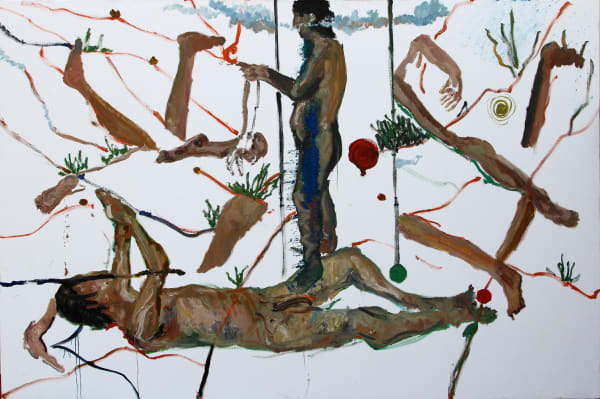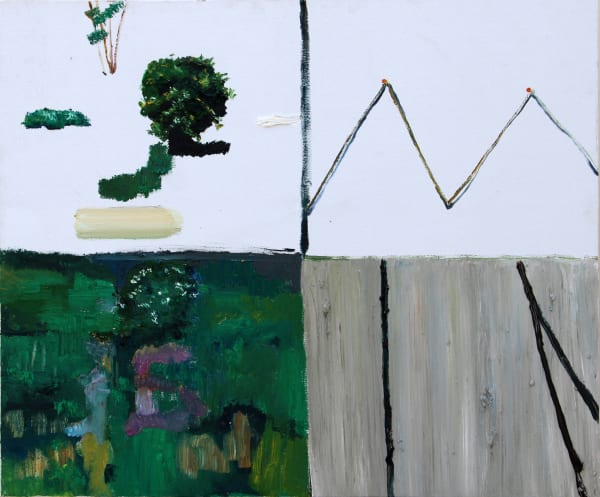Zheng Haozhong: Lee Cha
Who is Lee Cha?
Without a doubt, this character “Lee Cha” should be the protagonist of this exhibition.
Although storyboard or comic strip-like formal separations often appear in artist
Zheng Haozhong’s paintings, they offer no clear or logical narrative. From these
linearly divided compositions, we can only intermittently discern certain figural
shapes, postures, personalities, and scenarios derived therein. Through this we
gather various characteristics and clues related to the identity of “Lee Cha,” from his
life’s physical routine to an ineffable, hidden consciousness, provoking us to consider
whether this figure “Lee Cha” is actually real, or fictional.
The majority of the exhibition’s destructive tableaus are drawn from life. The creator
lives in a small, coastal town. His work largely relies on this natural environment, as
well as the few friends and relatives around him with whom he is close. He has built
a small, carefree world with himself as the absolute center. This lifestyle, a certain
contentment in mastering one’s small lot, and a painting practice built on a sense of
trust are perhaps shackles to his work. And yet the artist does achieve a certain
relative freedom in this.
This freedom is manifest in his mastery of the picture plane itself—what can remain,
what can be abandoned. The artist seizes upon dynamic changes that happen on
site, from a model who momentarily stands up, to the sprouting and withering of a
tree’s leaves throughout the year. Through his choices and adjustments on the
canvas, everything seems masterfully handled. Academic training has familiarized
him with the relationships between line and plane, positive and negative space,
abstraction and realism, looseness and restraint. Some works seem as if they were
made in one stretch. However, each of these pieces takes into account factors of
time, temperature, perspective, and other considerations, recombining different
dimensions of external appearance on the same canvas that ultimately evolves into
a perfect accident. Stripping away its fractured skin, his painting is like a process of
painstaking cultivation, maintaining a state that is closest to true nature. Outside of
the artist’s plans, he also embraces a delightful sense of chance, yet still the
composition, resonance, and layering of the different elements also abides by certain
principles. The work ultimately grows into a reasonable conclusion, giving off a
certain palpable sense of ease and maturity.
On the other hand, at times this freedom is also manifest in the artist’s private verdict
of certain targeted judgments. For instance, he will find some excuse to paint a
clothed model nude or dress a man in a woman’s pink outfit. In the last work of his
series “Qiu Chen”, Zheng had a falling out with his close friend and, feeling at a loss,
decided to burn Qiu Chen’s hair in the painting as an act of revenge. The model’s
sudden departure, leaving the artist to a situation in which all that remained was the
artist himself, provided Zheng with an opportunity to investigate the self, even if it
was a last resort. In this series of paintings the artist seemingly strives to defend
himself: either by way of tender monologue or intense interrogation, they oscillate
between narrative and unconscious rambling.
What these fragmentary works collectively foreshadow is not merely the image of
some “other” from the artist’s everyday life—a powerful “ego” can’t restrain itself from
encroaching and controlling. Always partly hidden and partly visible, spanning
throughout its entirety, the ego evitably pushes the viewer’s attention toward the
nature that underlies all intent. This includes the artist himself. What’s interesting is
that this inward observation perhaps originates in a narcissistic love and adoration.
The mirror has replaced the water’s surface, realizing a series of slightly affected
self-portraits. However, compared to the phantom in the mirror, the most truly
engaging self-evaluation exists within the circuit of interactions between the artist
and the small world he has delineated for himself. It is an ego hijacked by an
unavoidable reflexive power, as if laid beneath the pale, glaring, shadowless lamp of
an operating room, naked and dialyzing all the minutiae of the spirit beneath the skin,
including those lesions that have already infected the marrow. Humanity’s pride,
indolence, servility, and cowardice have created a situation in which self-perception
is like an arduous march forward in shackles.
Even more unfortunate, the perceptions and thoughts born from all these paths are
treasures that belong to Zheng Haozhong alone; painting is thus a form of
squandering. Stemming from a superstitious belief in insinuation and metaphor, we
can only rely on the strange and mysterious images within the artworks to guess at
the impulses that drive them. Nietzsche’s emphasis on the instinctive ability of the
unconscious, Freud’s theory that “the unconscious is the true psychical reality,”
Jung’s profound belief that psychic phenomenon must necessarily adhere to laws
outside of the laws of physics—all could be used as footnotes to Zheng’s painterly
rhetoric. Religious symbols evocative of “pentagram worship” and augury allow the
painted image to break free from everyday experience and memory, slipping into
the more profound and unpredictable “collective unconscious.” The artist eliminates
dependence upon physical time and banal space, taking the world of images
through the gash he has torn open. That uncontrolled ignorance forever inspires
fear and intimidation, as if the artist one day discovered he faced a shattering mirror.
As with countless other paralyzing occurrences, and all he can do is ascribe them to
fate and cast them into the underworld.
People no longer feel a sense of curiosity when faced with familiar things. When
absence arises they are far more able to capture the gaze, and from there the divine
appears as reality. The excitement of reading an artwork is because, in that moment,
it is as if we have collided with a mysterious and true instinct that lies hidden in that
which comes after. “Lee Cha” is both a figure in the painting and the figure who
paints. He is constantly reborn, yet he cannot break from the past. This exhibition is
only a beginning, letting us first meet this man named “Lee Cha.”











